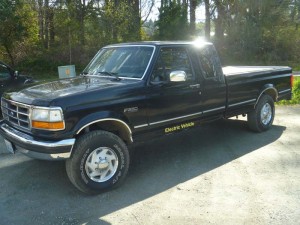Therapy for Fleet Managers: Benefits of Electric Vehicles

Therapy for Fleet Managers
Life has never been worse if you manage a transport fleet to meet revenue commitments. Volatile fuel costs, maintenance costs you can’t cut, and air pollution regs that can’t be complied with unless you can find capital for replacement vehicles. So too there’s the incessant dumping of carbon over the fence, which bothers you despite Dick Cheney’s success legislating exemptions from the Clean Air Act, the Clean Water Act, and toxic product labeling laws. You’re not happy with the declining environment you are leaving to your kids and grand kids, and it’s on your watch. You can also be looking at mandates to clean your fleet if you are funded by local government and serve the public, requiring a near term transition to alternative fuels.
If you are aware of the benefits offered by Natural Gas Vehicles (NGVs) for reducing carbon emissions you also know about the millions needed for building a specialized refueling infrastructure. Although there are possible savings in the cost of fuel, natural gas $/mile is more volatile than either gasoline or diesel, so trying to depend on the fuel price differential for affordable natural gas is a rough ride.
Battery electric trucks are coming on line although primarily for evaluation by the few fleets having deep pockets, and only for medium and light duty service. Electric Vehicle (EV) sales data are surging for passenger cars but no records are being set by EV truck sales. Affordable sticker prices for OEM electric trucks are stuck where they are, since price reductions from volume sales appear unlikely, even long term. Route assignments and financials are explored in this Green Fleet report, which deals with OEM trucks only.
The Alternative No One Noticed
Hobbyists have been changing out gas and diesel drive trains for decades for the joy of driving battery electric conversions – no emissions, cost/mile at 25% of fossil fuels, quiet comfort in your favorite car, a sense of distinction from designing the system and driving past every gas station you see. To convert a medium duty truck, you just scale up the voltages, currents, and battery kWh needed, essentially without any new design concepts. The resulting Converted Zero Emission Vehicle (CZEV) conserves the energy embodied during its original production.
Unlike the passenger car, it’s entirely fair to expect a converted medium duty service vehicle to earn back the cost of the conversion from fuel and maintenance savings. Fuel savings accrue from electric fuel costs that are 25% of diesel or gasoline. Maintenance cost is typically 50%. The financials are not rocket surgery. Payback is possible if the revenue-bearing route is long enough and mpg consumption is high enough. It helps if the conversion can be depreciated. Various types of electric conversions (cars, trucks) are titled and registered if they simply meet the standards and requirements for the vehicle type. An inspection is usually all that’s required.
The two reasons why this affordable climate saving and cost saving concept is not employed extensively are not often discussed, well, except here:

1) lithium battery technology maintenance and 2) high voltage safety. These are serious barriers that deter broad acceptance by fleet managers. The missing therapy takes shape when these concerns are successfully solved. It has taken the form of a 1995 F-250 long bed battery electric CZEV
Lithium Battery Management
The all-important battery packs are made up of multiple cells, each storing about 3.5 volts. Connected in Christmas tree strings they add up to hundreds of volts. Problem is, some cells run a little low while trying to supply the needed current, degrading their performance and shortening their service life. Some other cells can charge up faster than others, risking damage from cell overvoltage. The following battery maintenance functions are considered essential for fleet operation.
Cell Protection and Reporting.
Cell overvoltage can occur faster than it can be fixed, so an automatic protection circuit must be provided. There must be a means to report overvoltage if the protection circuit fails. Cell undervoltage must also be reported. These reports make it possible to service detected anomalies before damage to a cell can occur.
Emergency Isolation
Assuming a fully capable battery pack, there are fault conditions elsewhere in the electric drive train that are mitigated by temporarily disabling the battery pack. Fuses, fuse breakers and contactors can be opened, resulting instantly in zero current and low voltages.
Reporting State of Charge
With the driver aware that the battery is fully charged leaving the gate, with a known ampere-hour capability of 140 AH, a dashboard meter is provided to display the accumulated AH consumed while under way. As the meter increases toward 70AH, it’s time to either return to base or connect to a charge station. Running with an average energy consumption of 25kW means the truck can cruise for at least 2 hours straight, fed by the 60 kWh pack.
Expensive “Battery Management” systems drive up the cost, to undermine the affordability of the CZEV. Even the best BMS does not obviate the need for a battery support technician to periodically charge individual cells, and to replace cells that are impacting the pack performance or running too hot.
Our minimalist approach is to provide adequate maintenance functions with the simplest design for the monitor circuit at each cell as well as for the pack reporting logic:
- Cell Protection
- Condition Reporting
- Emergency Isolation
Broader BMS processing is available for additional cost.
- Providing information on the State of Health (SOH) of the battery. This measurement gives an indication of the condition of a used battery relative to a new battery, estimating the service life remaining. Even with considerable data gathering from each cell, evaluated by complex algorithms, the results are notoriously unreliable.
- Predicting the range possible with the remaining charge in the battery. Predictive reporting is a very difficult problem. For the OEM passenger EVs having this feature, the users often refer to the range indicator as a “Guess O Meter”.
- Accepting and implementing control instructions from related vehicle systems. Lacking precise data collection and mature processing software, control instructions cannot be effective, no matter what control is being attempted
- Providing means of access for automated charging of individual cells. This means applying a control link to every cell. Then its necessary to add complexity to monitor the health of the controls. A battery support technician does this best. If accomplished with an automated BMS, a battery support technician must still be trained in BMS support diagnostics.
- Responding to changes in the vehicle operating mode. It adds unnecessary complexity when modes are defined beyond simply “OFF, CHARGING, ON.”
- Recording battery usage and abuse. Automatically recording the frequency, magnitude and duration of out of tolerance conditions is known as the Log Book function. Additional software is needed to process and report this data, adding cost.
High Voltage Safety
Operational safety interlocks are integrated into the F-250 CZEV design. The “Uncontrolled Lexus 350” hazard is mitigated 4 ways.
- The Zilla DC Motor Controller shuts down safely when hazardous fault conditions are detected, isolating the motors from the drive energy source.
- The Ignition switch opens the connection from the battery pack to the controller.
- A dashboard button is provided to open multiple battery pack circuit breakers (normally used for safe maintenance).
- The manual clutch and gear box allow breaking the mechanical link from motors to drive train.
Additional safety margins can be achieved if a “brake-throttle override” is employed, and if an AC motor and controller are incorporated in place of DC motor/controller components. Again, these impact affordability. In general, a minimum of 3 independent interlocks is the industry standard for mitigation of critical hazards.
Fleet Manager Resources
Better Energy LLC has published a design and performance report for the F-250 CZEV demonstrator truck CZEV Design & Performance. Additional resources are offered to the fleet manager who finds the CZEV option worthy of further consideration. A CZEV High Voltage Safety Handbook has been compiled with references, and includes high voltage design schematics for the F-250. This is available for a nominal fee at the Better Energy LLC web page.
A separate publication discloses the Battery Pack Cell Protection, Reporting and Isolation circuit design, together with a detailed CZEV Major Component Parts List.
Clients who participate with these purchases will gain access to the CZEV Clearinghouse publications, which report client fleet field experience, lessons learned, design improvements, reported savings together with state and federal incentives for ZEVs and CZEVs. Some fleets may regard the CZEV as an effective tool to train staff while conserving capital for downstream new OEM ZEV acquisition.
A Note to Fleet Managers
You have just been provided access to years of research, planning and design. Not as significant as the recent open source release of Tesla patent files, but more directly applicable. You should be reconsidering your plan for transitioning to alternative fuels, assuming there is one. This is because you have the most responsibility for deciding to release huge amounts of spent carbon into the environment every day, while also having the most authority over alternative fuel planning and implementation. Time to do something different.
You should be prepared to answer the following concerns.
- What have you done to date to cut fleet carbon release and polluting emissions?
- What budgetary resources have you requested to eliminate fleet carbon releases in the near term, using alternative fuels?
- What elements of your emission control planning address affordable reuse of fleet vehicles converted to clean alternative fuel?
- Who on your staff is conversant with traction battery diagnostics and maintenance?
A final caution. Whatever you do, if you are really serious about conserving fuel cost, conserving fleet capital expense, conserving local air quality, or conserving the environment from CO2 and CH4 emissions, please avoid paying any attention to the following page.

